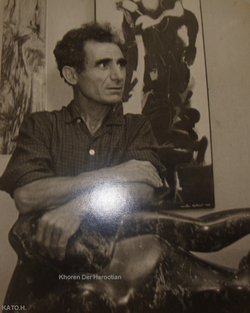Armenian-American artist Khoren Der Harootian had a prolific career and achieved national and international recognition for his sculptures, which are found in public and private collections throughout the world.
Der Harootian (Der Harootioonian) was born in Ashodavan, a village of Kharpert, in Western Armenia, on April 2, 1909. He came to the United States with his mother and sisters in 1921 after witnessing and surviving the Armenian Genocide, where Rev. Fr. Harootioon Kehyayan, his father, and twenty-two relatives were massacred.
He lived in Worcester, Massachusetts, and attended the art school of the local art museum while he was still a high school student. He had the first exhibition of his watercolors in Provincetown (1928). He went to New York and studied at the National Academy School of Fine Arts on a scholarship. After having an exhibition in New York (1929) with good success, in 1930 he moved to Jamaica to paint, and became fascinated with sculpture, primarily carving in the island’s native hardwoods. After various exhibitions in Jamaica and New York, Der Harootian visited London in 1939 and had his paintings and first sculptures exhibited in group shows.
In 1944 Der Harootian came back to the United States from Jamaica and had his first one-man show of paintings and sculpture at the Kraushaar Gallery, New York, in 1945. After his open-air exhibition at Washington Square in 1948, the Metropolitan Museum acquired his sculpture “Prometheus and the Vulture.” Working in his New York studio, he concentrated on sculpture in stone and marble.
The 1950s-1970s period was the most significant in Khoren Der Harootian’s career. His works expressed his feelings against war, genocide, and violence with a modern style. Among various prizes over the years, in 1954 he won the George D. Widener Gold Medal of the Pennsylvania Academy and an award from the American Academy and the National Institute of Arts and Letters.
He spent 1962-1963 in Italy exploring new forms and realizing new conceptions for casting in bronze. A comprehensive one-man show of his bronzes, stone carvings, watercolors and drawings was held in 1964 at the Zwemmer Gallery in London, where he had exhibited for the first time in 1938.
From the 1960s onwards, many of Der Harootian’s sculptures were dedicated to Armenian subjects, including various episodes of the epic “David of Sassoon,” as well as various historical and cultural heroes like Vartan Mamikonian, Mesrop Mashtots, Sahak Bartev, Mount Ararat, et cetera. In 1965, Der Harootian had a one-man exhibition of his bronzes, stone, and wood carvings, watercolors, and pastels at the Armenian General Benevolent Union Gallery In New York. He had a one-man show of his work at the Contemporaries Gallery, New York, in 1967. He visited Armenia for the first time in 1971, invited by the Armenian Society of Cultural Relations and Friendship Abroad, and presented his works in an exhibition held at the Artists’ House in Yerevan. In the same year, he also had a one-man exhibition of sculpture, watercolors and drawings held at the Bernheim Gallery in Paris.
He was commissioned by the Philadelphia Armenian Bicentennial Commemoration Committee in 1974 to create a bronze memorial to the martyrs. His 22-foot bronze sculpture, “Young Meher” stands in front of the Philadelphia Museum of Art and was unveiled on April 24, 1976. “It seemed like I was in a sacred ceremony and I was not the sculptor, but the souls of the martyrs were directing my hands. When I finished the statue after two long years of work, I felt on the ladder that I had achieved my revenge, and suddenly… my tears flowed…” the sculptor declared in 1978 during a visit to Armenia.
In 1983 Der Harootian donated 88 sculptures and more than 100 paintings to Armenia. A year later he won the Mardiros Saryan medal of the Armenian government.
The artist passed away on February 17, 1991, after being hit by a car in New York. A permanent exhibition of his works was opened in 1994 in the Echmiadzin branch of the National Gallery of Armenia.

